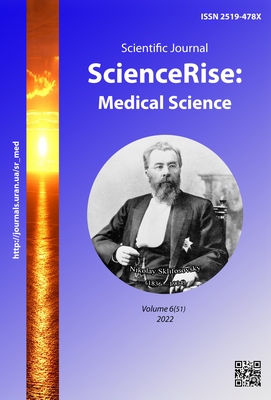Comparison of anterior segment parameters in normal and keratoconus eyes using combined placido-disk schiempflug imaging-based topography
DOI:
https://doi.org/10.15587/2519-4798.2022.270264Keywords:
keratoconus, Placido-Scheimpflug imaging-based topography, anterior curvature, posterior curvature, Fleischer ring, Vogt striae, anterior stromal scar on slit-lamp examinationAbstract
The aims: The purpose of this study was to evaluate and compare the anterior and posterior corneal surface parameters, keratoconus indices, thickness profile data, and data from enhanced elevation maps of keratoconus and normal corneas using Combined Placido-Schiempflug imaging-based topography, and to determine the sensitivity and specificity of these parameters in discriminating keratoconus from normal eyes.
Materials and methods: A retrospective comparative observational study of 100 normal eyes and 100 keratoconus eyes was done from April 2014 to May 2015 at MM Joshi Eye Institute, Hubli, Karnataka. We evaluated and compared the anterior and posterior corneal surface parameters, keratoconus indices, thickness profile data, and data from enhanced elevation maps of keratoconus and normal corneas using Combined Placido-Scheimpflug Imaging based Topography to determine the sensitivity and specificity of these parameters in discriminating keratoconus from normal eyes.
Results: Keratoconus indices (Sif, Sib, BCV-f, BCV-b, KVf, KVb, CCT, MinCT) showed Excellent AUROC values followed by K- steep in posterior curvature at 3 mm, 5 mm followed by K- steep in anterior curvature and other parameters in discriminating Normal from Keratoconus-Suspect eyes. Elevation indices- BCV-f, BCV-b, CCT, Min-CT, K-steep & K-flat in anterior and posterior curvature in 3 mm, 5 mm, 7 mm, and CV were significant in discriminating normal from mild keratoconus. All parameters except ACV and ICA were significant in discriminating normal from moderate keratoconus. All parameters were significant in discriminating normal from severe keratoconus eyes. Morphological indices were significant in differentiating mild, moderate and severe keratoconus.
Conclusion: Many parameters were statistically significant between keratoconus and normal eyes compared with early keratoconus eyes.
The topography and corneal aberration results in this study are promising for detecting ectatic corneas. In our study, thickness indices-CCT, MinCT, Abberometry indices- BCVf, BCVb and keratometry in steep meridian at posterior curvature had the highest AUC scores in differentiating normal from sub-clinical keratoconus.
Elevation indices- Rbf-f, Rbf-b, thickness indices- CCT, MinCT, aberrometry indices, and keratometry-steep in anterior & posterior curvature had the highest AUC scores in differentiating moderate and severe keratoconus
References
- Romero-Jiménez, M., Santodomingo-Rubido, J., Wolffsohn, J. S. (2010). Keratoconus: A review. Contact Lens and Anterior Eye, 33 (4), 157–166. doi: https://doi.org/10.1016/j.clae.2010.04.006
- Li, X. (2004). Longitudinal study of the normal eyes in unilateral keratoconus patients. Ophthalmology, 111 (3), 440–446. doi: https://doi.org/10.1016/j.ophtha.2003.06.020
- Klyce, S. D. (2009). Chasing the suspect: keratoconus. British Journal of Ophthalmology, 93 (7), 845–847. doi: https://doi.org/10.1136/bjo.2008.147371
- Bühren, J., Kook, D., Yoon, G., Kohnen, T. (2010). Detection of Subclinical Keratoconus by Using Corneal Anterior and Posterior Surface Aberrations and Thickness Spatial Profiles. Investigative Opthalmology & Visual Science, 51 (7), 3424. doi: https://doi.org/10.1167/iovs.09-4960
- Bühren, J., Kook, D., Yoon, G., Kohnen, T. (2010). Detection of Subclinical Keratoconus by Using Corneal Anterior and Posterior Surface Aberrations and Thickness Spatial Profiles. Investigative Opthalmology & Visual Science, 51 (7), 3424–3432. doi: https://doi.org/10.1167/iovs.09-4960
- Montalbán, R., Alió, J. L., Javaloy, J., Piñero, D. P. (2013). Intrasubject repeatability in keratoconus-eye measurements obtained with a new Scheimpflug photography–based system. Journal of Cataract and Refractive Surgery, 39 (2), 211–218. doi: https://doi.org/10.1016/j.jcrs.2012.10.033
- Calossi, A. (2004). Screening by computerized videokeratography. Il Cheratocono. Canelli: SOI Publ. Group, Fabiano Group, Ltd, 114–117.
- de Sanctis, U., Loiacono, C., Richiardi, L., Turco, D., Mutani, B., Grignolo, F. M. (2008). Sensitivity and Specificity of Posterior Corneal Elevation Measured by Pentacam in Discriminating Keratoconus/Subclinical Keratoconus. Ophthalmology, 115 (9), 1534–1539. doi: https://doi.org/10.1016/j.ophtha.2008.02.020
- Uçakhan, Ö. Ö., Çetinkor, V., Özkan, M., Kanpolat, A. (2011). Evaluation of Scheimpflug imaging parameters in subclinical keratoconus, keratoconus, and normal eyes. Journal of Cataract and Refractive Surgery, 37 (6), 1116–1124. doi: https://doi.org/10.1016/j.jcrs.2010.12.049
- Miháltz, K., Kovács, I., Takács, Á., Nagy, Z. Z. (2009). Evaluation of Keratometric, Pachymetric, and Elevation Parameters of Keratoconic Corneas With Pentacam. Cornea, 28 (9), 976–980. doi: https://doi.org/10.1097/ico.0b013e31819e34de
- Smadja, D., Santhiago, M. R., Mello, G. R., Krueger, R. R., Colin, J., Touboul, D. (2013). Influence of the Reference Surface Shape for Discriminating Between Normal Corneas, Subclinical Keratoconus, and Keratoconus. Journal of Refractive Surgery, 29 (4), 274–281. doi: https://doi.org/10.3928/1081597x-20130318-07
- Smadja, D., Touboul, D., Cohen, A., Doveh, E., Santhiago, M. R., Mello, G. R., Krueger, R. R., Colin, J. (2013). Detection of Subclinical Keratoconus Using an Automated Decision Tree Classification. American Journal of Ophthalmology, 156 (2), 237-246.e1. doi: https://doi.org/10.1016/j.ajo.2013.03.034
- Piñero, D. P., Alió, J. L., Alesón, A., Vergara, M. E., Miranda, M. (2010). Corneal volume, pachymetry, and correlation of anterior and posterior corneal shape in subclinical and different stages of clinical keratoconus. Journal of Cataract and Refractive Surgery, 36 (5), 814–825. doi: https://doi.org/10.1016/j.jcrs.2009.11.012
Downloads
Published
How to Cite
Issue
Section
License
Copyright (c) 2022 Pasumarthi Pavani Yelamanchili, Madhuri Kurakula, Mannam Gitanjali, Kotagiri Srawanthy

This work is licensed under a Creative Commons Attribution 4.0 International License.
Our journal abides by the Creative Commons CC BY copyright rights and permissions for open access journals.
Authors, who are published in this journal, agree to the following conditions:
1. The authors reserve the right to authorship of the work and pass the first publication right of this work to the journal under the terms of a Creative Commons CC BY, which allows others to freely distribute the published research with the obligatory reference to the authors of the original work and the first publication of the work in this journal.
2. The authors have the right to conclude separate supplement agreements that relate to non-exclusive work distribution in the form in which it has been published by the journal (for example, to upload the work to the online storage of the journal or publish it as part of a monograph), provided that the reference to the first publication of the work in this journal is included.









